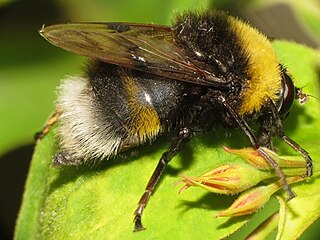
Syritta is a genus of hoverflies, family Syrphidae.

Xylota is a Holarctic genus of hoverflies similar in structure to the related genera Chalcosyrphus and Brachypalpoides. As the larvae are saprophytic they're usually found in rotting wood. The adult flies are generally associated with woodland and woodland edges and can often be seen running over the upper sides of leaves. Unlike other syrphids the adults of many species rarely visit flowers preferring instead to gather pollen from leaf surfaces. There are over 100 described species of which 12 can be found in Europe. Seven species have been recorded in Britain. Identification of species has been difficult and identifiction by photographs is risky.

Pseudolynchia are genus of biting flies in the family of louse flies, Hippoboscidae. There are 5 known species. One of the more well known species is the pigeon louse flyPseudolynchia canariensis. All species are parasites of birds.
Jurinia is a genus of flies in the family Tachinidae.
Sphaeniscus sexmaculatus is a species of tephritid or fruit flies in the genus Sphaeniscus of the family Tephritidae.

Blera is primarily a North American genus, though there are 3 species from Europe. The genus is characterized by the following characters:

Pocota is a genus hoverflies, from the family Syrphidae, in the order Diptera.

Tropidia is a genus hoverflies, from the family Syrphidae, in the order Diptera.
Neoascia metallica, the Double-banded Fen Fly, is a common species of syrphid fly observed across North America. Hoverflies can remain nearly motionless in flight. The adults are also known as flower flies, for they are commonly found on flowers, from which they get both energy-giving nectar and protein-rich pollen. The larvae are aquatic.

Sphecomyia is a genus of hoverfly in the family Syrphidae. There are about 16 described species in Sphecomyia.

Chalcosyrphus (Xylotomima) piger, the short-haired leafwalker, is an uncommon species of syrphid fly found throughout North America and Europe. Hoverflies get their names from the ability to remain nearly motionless while in flight. The adults are also known as flower flies, for they are commonly found around and on flowers, from which they get both energy-giving nectar and protein-rich pollen. Larvae have been identified from sappy hollows from Larix and Pinus.
Syritta orientalis is a species of syrphid fly in the family Syrphidae.
Syritta indica is a species of syrphid fly in the family Syrphidae.
Syritta latitarsata is a species of syrphid fly in the family Syrphidae.
Syritta nigrifemorata is a species of syrphid fly in the family Syrphidae.
Syritta leucopleura is a species of syrphid fly in the family Syrphidae.
Syritta vitripennis is a species of syrphid fly in the family Syrphidae.
Tropidia flavipicta is a species of hoverfly in the family Syrphidae.
Tropidia nigricornis is a species of hoverfly in the family Syrphidae.
Neoascia distincta is a species of Hoverfly in the family Syrphidae.








